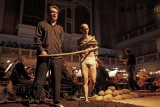Blood, sand, stones: in Lars Scheibner’s staging of MacMillan’s St. John Passion (2009), the Passion story becomes sensually palpable.
After Johann Sebastian Bach, to write another St. John Passion is a daring undertaking. The Scottish composer James MacMillan (b. 1959) does not attempt to avoid his great model. On the contrary, he invokes it but re-interprets the artistic elements.
The role of the Evangelist is taken by a four-voice narrating ensemble. Only Christ is sung by a soloist; all the other figures are given to the chorus. In place of Bach via Crucis’s chorales, MacMillan ends each of the Passion’s nine vocal movements with choral commentary. The work concludes with an instrumental epilogue.
Choreographer Lars Scheibner sets a dancer against the soloists on a narrow “Way of the Cross” in front of the orchestra platform, thereby spotlighting Jesus’ dual nature: the dualities of Man-God, body-spirit, humiliated-triumphant. The media of orchestral sound, the human voice and the human body confront the materials of earth, stone and wood. Earth stands for the creation of the body, stone for the via Crucis, wood for the Cross. Thus the substance of the Passion story becomes sensually palpable.



